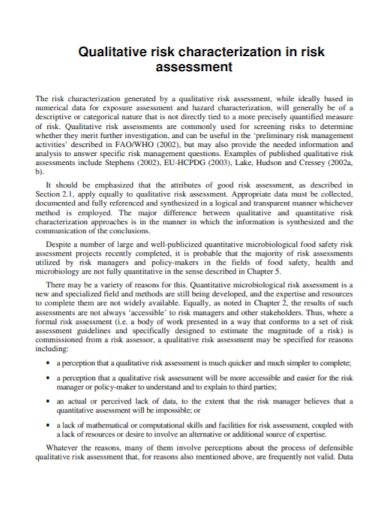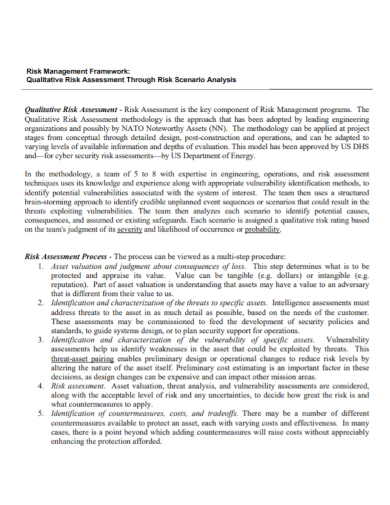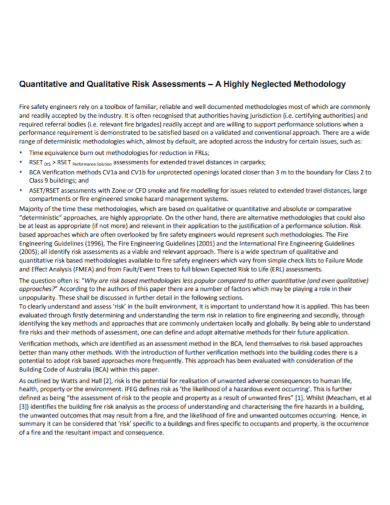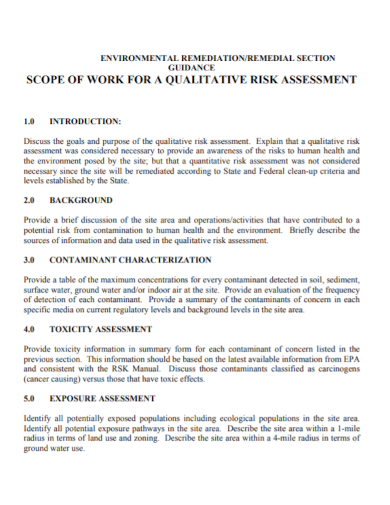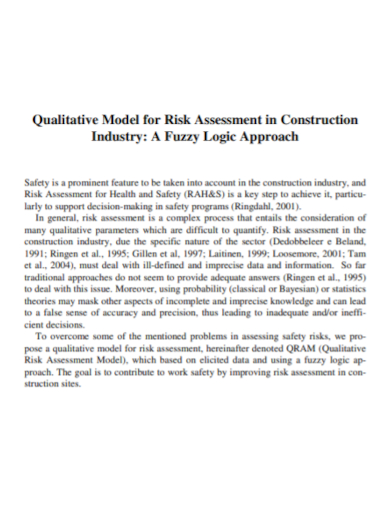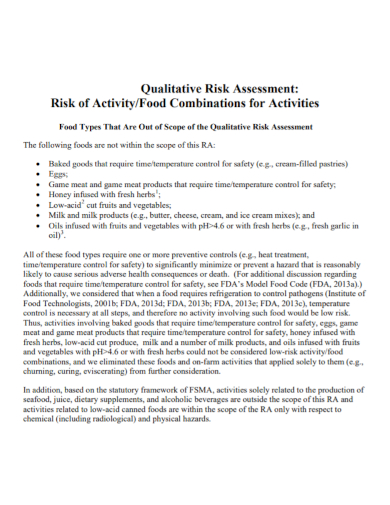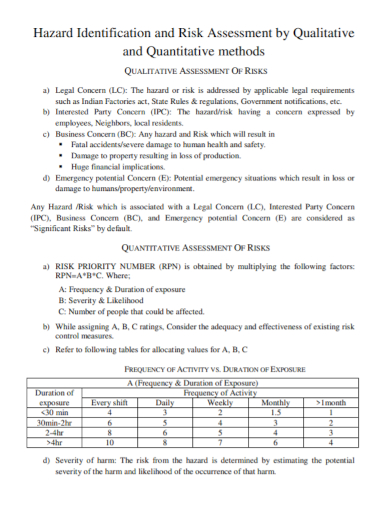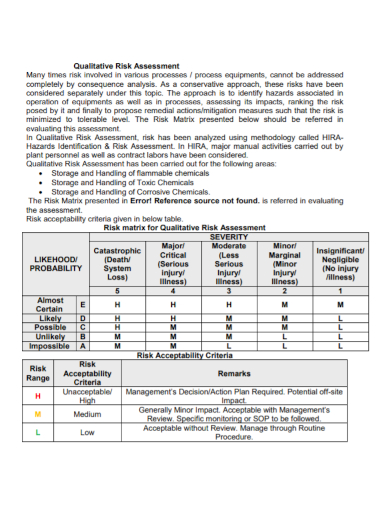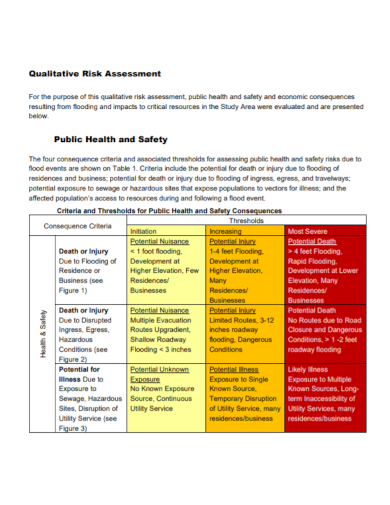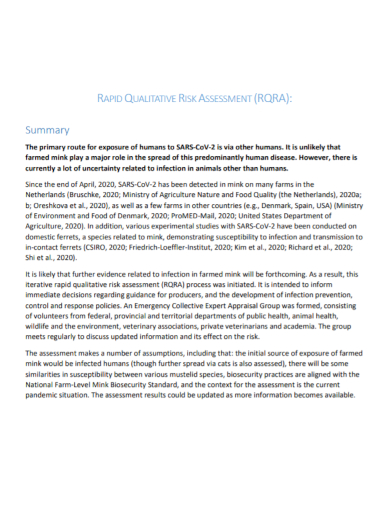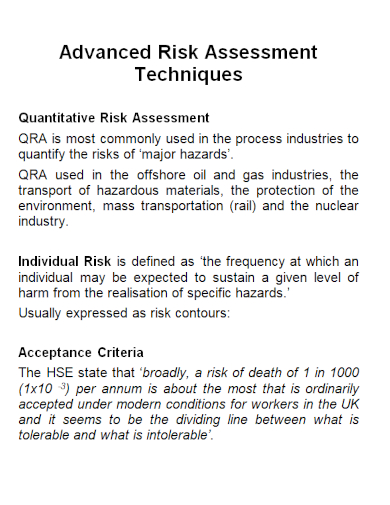Qualitative risk assessment is one of the most important tasks to do when managing an important project that could impact a large number of people or change the norm or costs a lot of money. By knowing what risks underlies every project, you can easily find out those risks and do the appropriate actions to prevent or mitigate or solve those risks that could create a negative impact on your project. If you’re handling a project and you need to do a risk assessment and you don’t know how to do it, you’ve come to the right article. Read the rest of the article to know how to do a qualitative risk assessment.
10+ Qualitative Risk Assessment Samples
1. Qualitative Risk Assessment
2. Qualitative Risk Management Assessment
3. Quantitative and Qualitative Risk Assessment
4. Environmental Qualitative Risk Assessment
5. Construction Industry Qualitative Risk Assessment
6. Qualitative Food Risk Assessment
7. Hazard Identification Qualitative Risk Assessment
8. Sample Qualitative Risk Assessment
9. Health and Safety Qualitative Risk Assessment
10. Rapid Qualitative Risk Assessment
11. Qualitative Advanced Risk Assessment
What is a Qualitative Risk Assessment?
Qualitative risk assessment is a process that quantifies risks associated with a particular hazard using a rating scale. Risk assessment is used for measuring hazardous events that have a likelihood of hazardous outcomes that could result in significant consequences.
How to Do a Qualitative Risk Assessment
1. Identify the Risks
To identify the risks, start thinking of any situation or instances that could have an uncertain effect on your project, identify first the obvious risks and from there you can look at those risks more closely and see other risks that you haven’t identified at first. You can use the tools for risk identification such as mind maps, questionnaires, interviews, documentation review, checklist analysis, and SWOT analysis to help you identify the risks.
2. Analyze Their Impact
After you identified the possible risks, the next thing to do is consider their potential impact. You can segregate the risks into threats and opportunities and estimate each risk of their probability to occur and their impact on a scale of 1-5 (with 5 being the highest or extreme). Once you’ve determined their scores from the scale, take those and combine them to create a total risk ranking.
3. Treat Each Risk
The next thing to do is to apply treatments to each risk. There are many ways of dealing with and treating these risks, but it is up to you on what the best treatment will be done for each risk. However, below are some options that you can do for treatment to your risks:
- Accept: This is the recommended way of risk treatment if the risk has low impact and low probability, or if the cost of preventing the risk it is too high since it is more cost-effective to accept it.
- Mitigate: Some risks have a high probability so this means you can’t avoid them from happening. However, you can mitigate the impact of the risk if they become an issue.
- Exploit: To do this, you must be highly experienced to spot opportunities in the risks that you can turn into a benefit for you. You can seek out risk experts to help you exploit these risks.
- Transfer: This type of treatment is useful when the impact hits the financial aspect. You can transfer these risks to a third party. One example of this type of treatment is getting insurance; the insurance party will assume the risk on your behalf, so you don’t suffer too hard if the impact resulted in something that went wrong.
- Avoid: If you can’t do anything above because the risk is too high, the only thing to do is to avoid it. The risks can be avoided by changing or removing certain scope items or changing the approach.
You can also create a contingency plan to help you save time and money. A contingency plan can help you know what to do if the risks have happened in real-time, and knowing what to do helps you respond faster helping to reduce the risk impact.
FAQs
What are the benefits of a qualitative risk assessment?
Qualitative risk assessment can help people identify the risks in your work environment since it will help clarify the risks that are present and prioritize dealing with them quickly. They are also cost-effective too because they tend to diminish the risks before they can happen to result in costly impacts. Furthermore, the assessment is simple and doesn’t require too many tools or software, and they are easy to identify and treat right away.
What are the types of qualitative risk assessment?
The five most common types of risks assessment are probability and consequence matrix, bow tie analysis, Delphi technique, SWIFT analysis, and Pareto principle.
Remember that risk management will never be over, even if your project has finished. As your project progresses, always log your risks and made sure they’re up to date. Reviewing your risks regularly will help keep you on the changes of those risks; whether they escalate or fluctuate. Record your risk assessment so that you can use this as your reference in future risk assessments of your projects. To help you get started doing the risk assessment, download the free sample templates above to use as your guide.
Related Posts
FREE 10+ Market Assessment Samples in PDF | MS Word
FREE 10+ Quality Risk Assessment Samples [ Control, Assurance, Management ]
FREE 6+ Immediate Termination of Lease Agreement Samples in MS Word | Google Docs | Apple Pages | PDF
FREE 10+ Comprehensive Needs Assessment Samples in PDF
FREE 10+ Evaluation Quality Assessment Samples [ Self, Loss, Data ]
FREE 10+ Promotion Assessment Samples [ Health, Self, Employee ]
FREE 10+ Environmental Impact Assessment Samples in PDF | DOC
FREE 10+ Employee Competency Assessment Samples in PDF | DOC
FREE 10+ Safety Assessment Samples [ Home, Health, Risk ]
FREE 10+ Change Impact Assessment Samples [ Management, Control, Request ]
FREE 10+ Qualitative Assessment Samples in PDF | DOC
FREE 10+ Staff Assessment Samples [ Workplace, Health, Risk ]
FREE 10+ Vulnerability Assessment Samples [ Security, Network, Risk ]
FREE 6+ Vendor Risk Assessment Samples [ Management, Security, Financial ]
FREE 10+ Work Assessment Samples [ Social, Capability, Risk ]

